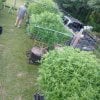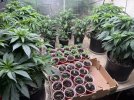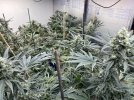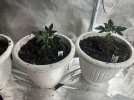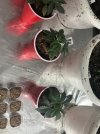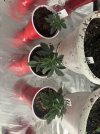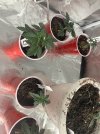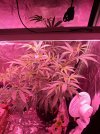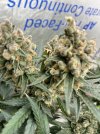| Organic fertilizer, amino acid and bio-organic fertilizer | Fusarium oxysporum f.sp. lycopersici, and Ralstonia solanacearum | Rhizosphere bacteria and fungi | Biological products reduced bacterial and Fusarium wilt diseases, and increased tomato fruit yields and the abundance of bacteria and fungi in the rhizosphere. | Liu et al. (Citation2017) |
| Organic soil additive (compost) | F. oxysporum f.sp. lycopersici (fol) | Rhizosphere bacteria and fungi | Additive suppressed fol by increasing the abundance of certain Fusaria-antagonistic groups in Bacillales (Bacillus and Paenibacillus), Pseudomonadales (Pseudomonas), Streptomycetales (Streptomyces), Eurotiales (Aspergillus and Penicillium) and Mortierellales (Mortierella). | De Corato et al. (Citation2020) |
| Organic (rice, cattle manure, and biogas residue) and bio-organic fertilizers (rice, cattle manure, and biogas residue and Streptomyces microflavus G33) | R. solanacearum | Rhizosphere bacteria and fungi | Bio-organic fertilizers had the highest inhibitory effect against R. solanacearum, thus reducing disease incidence. Applying bio-organic fertilizer reduced the abundance of R. solanacearum and increased the abundance of beneficial microbes. | Shen, Lei, et al. (Citation2021) |
| Biochar, calcium silicate humic acid and bio-organic fertilizer | R. solanacearum | Rhizosphere bacteria and fungi | Bio-organic additives demonstrated the highest inhibitory effect against bacterial wilt by influencing the microbial community in the rhizosphere. | Wang et al. (Citation2022) |
| Bio-organic (soybean cake, Pleurotus eryngii, pig manure and microbes) and organic fertilizers (organic matter, amino acids, N + P2O5 + K2O) | R. solanacearum | Rhizosphere bacteria | Biological products increased the abundance of Bacteroidetes, Actinobacteria, and Firmicutes, while reducing bacterial wilt and increasing available soil nutrients. Members of Terrabacter, Acidovorax, Truepera, Mycobacterium and Oxalicibacterium were enriched in rhizosphere soil following bio-organic additives. | Zheng et al. (Citation2020) |
| Bio-organic fertilizer (rapeseed, chicken manure, compost and Bacillus amyloliquefaciens T-5) and organic fertilizers (same as bio-organic but no microbe) | R. solanacearum | Rhizosphere bacteria | Biological products stimulated the bacterial community in the rhizosphere and suppressed R. solanacearum. Upon pathogen invasion, members of Sphingomonadaceae and Xanthomonadaceae increased in the treated plant rhizosphere. | Deng et al. (Citation2022) |
| Anaerobically prepared sewage sludge | F. oxysporum f.sp. lycopersici (fol) | Rhizosphere bacteria | Increased abundance of antagonistic bacteria members such as Bacillus, Chitinophaga, Flavihumibacter, Flavobacterium and Pseudomonas reducing Fusarium wilt incidence. | De Corato et al. (Citation2023) |
| Bio-organic fertilizer (rapeseed, chicken manure, compost and Bacillus amyloliquefaciens) | R. solanacearum | Rhizosphere bacteria, fungi and protists | Increased abundance of predatory protists to reduce pathogen density, resulting in reduced bacterial wilt incidence. | Guo et al. (Citation2024) |
| Bio-organic fertilizer (chicken manure compost and Bacillus amyloliquefaciens) | R. solanacearum | Rhizosphere bacteria | Increased abundance of antagonistic bacteria and bacterivorous nematodes. Antagonistic bacteria and bacterivorous nematodes synergistically reduced pathogen density, reducing bacteria wilt incidence. | Xu et al. (Citation2024) |

